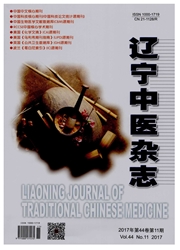

 中文摘要:
中文摘要:
目的以肠三叶因子(TFF3)和B细胞淋巴瘤基因-2(Bcl-2)两种蛋白为切入点,探讨萎胃康治疗慢性萎缩性胃炎(CAG)的可能机制。方法 SD大鼠84只随机分为造模组70只,正常对照组14只。采用复合造模法制备CAG大鼠模型,经6 w造模成功后,将造模组剩余的60只大鼠随机分为模型对照组及萎胃康高、中、低剂量组和阳性药物组(12只/组)。各组给予相应的药物,每天灌胃1次,连续治疗30 d后,分别用Realtime PCR法和Western印迹法检测各组大鼠胃黏膜TFF3和Bcl-2两种蛋白的表达。结果与正常组比较,模型组大鼠胃黏膜TFF3 mRNA表达和Bcl-2蛋白表达均显著升高(P〈0.05);与模型组比较,各治疗组大鼠胃黏膜TFF3 mRNA表达和Bcl-2蛋白表达均显著降低(P〈0.05);其中以萎胃康高剂量组降低最明显,较萎胃康中、低剂量组有显著差异(P〈0.05)。结论抑制胃黏膜TFF3和Bcl-2表达是萎胃康颗粒治疗CAG的机制之一。
 英文摘要:
英文摘要:
Objective To observe the effect of Weiweikang on the expressions of intestinal trefoil factor( TTF3) and B cell lymphoma 2( Bcl-2) in chronic atrophic gastritis( CAG) in rats. Methods 84 SD rats were randomly divided into model( n = 70) and blank groups( n = 14). CAG models were induced by composite molding method. After model induction,60 remaining rats in model group were equally and randomly divided into model,Weiweikang high,middle and low dose and positive drug groups. Rats of each group were given the corresponding drug once daily. After treatment for 30 days,the expression of TTF3 mRNA was detected by Real-time PCR and the expression of Bcl-2 was detected by Western blot. Results Compared with those of normal group,the expressions of TTF3 and Bcl-2 in model group were significantly increased( P〈0.05). Compared with those of model group,the expressions of TTF3 and Bcl-2 in each treatment group were significantly reduced( P〈0.05). The expressions of TTF3 and Bcl-2 in Weiweikang high dose group were reduced most obviously compared with those of Weiweikang middle and low dose groups( P〈0.05).Conclusions The mechanism of Weiweikang treating CAG might be related to inhibiting the expressions of TTF3 and Bcl-2.
 同期刊论文项目
同期刊论文项目
 同项目期刊论文
同项目期刊论文
 期刊信息
期刊信息
